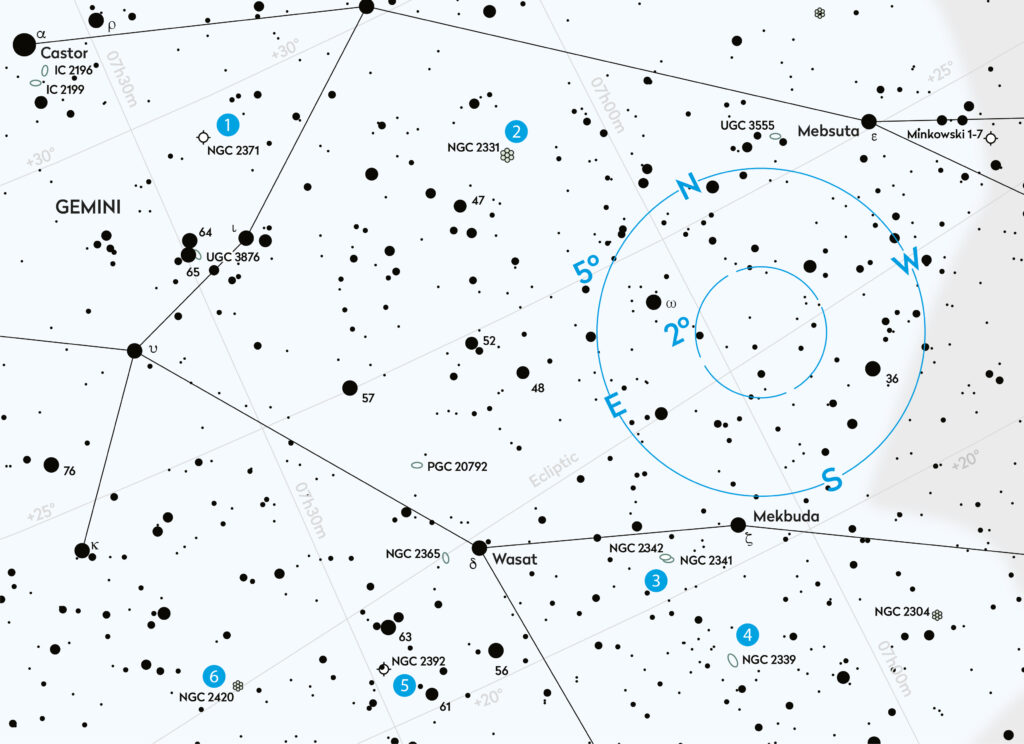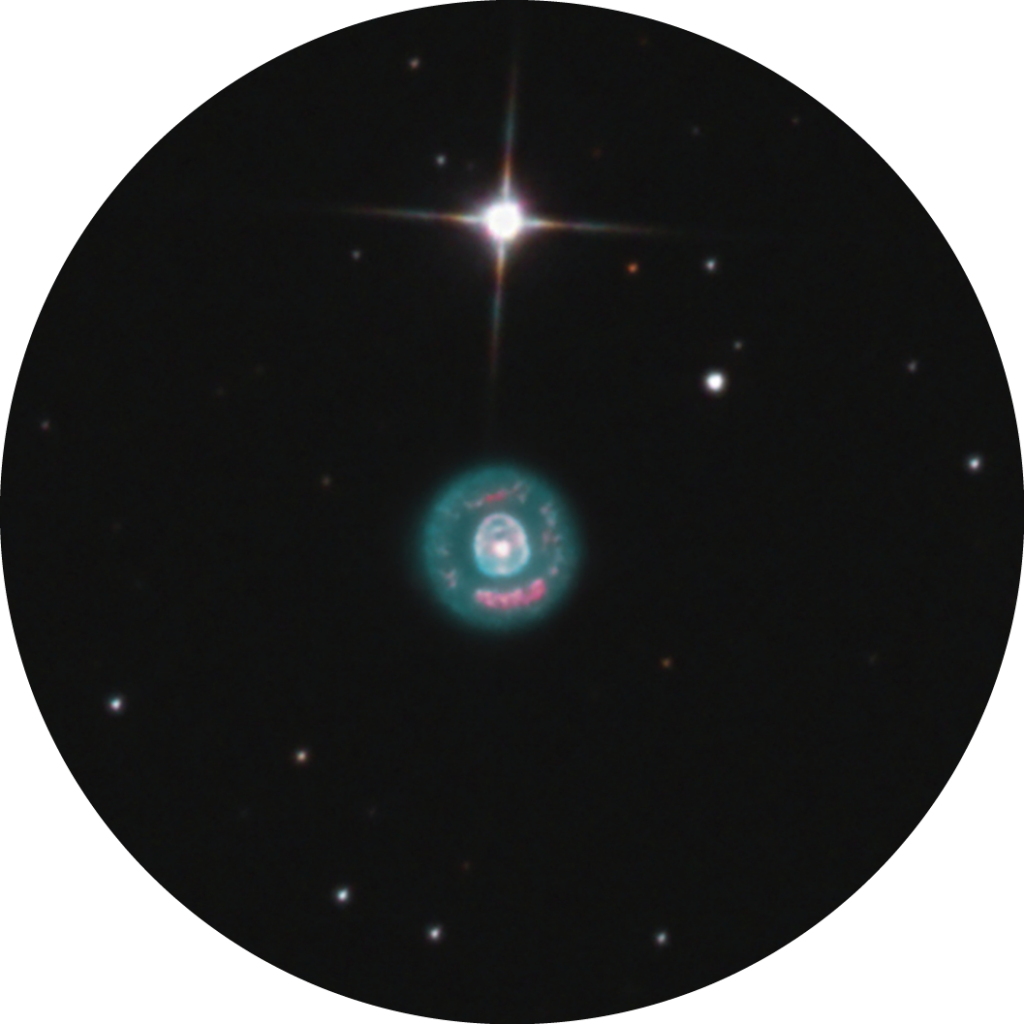Set your sights on the twins as our March tour takes us to six gems in Gemini

1. NGC 2371/72
Recommended equipment: Small/medium or large telescope
NGC 2371 is catalogued twice, as NGC 2371 and NGC 2372, a consequence of it appearing as two separate objects. A mag. +11.3 planetary nebula, NGC 2371/72 is located 1.7° north of mag. +3.8 Iota (ι) Geminorum. A 150mm scope shows a faint haze with an embedded star-like feature. A 250mm scope reveals the dual nature, two lobes connected by a haze, the southwestern lobe brighter and tighter with a star-like core. The central star sits between lobes, requiring a large scope to see at mag. +14.8. The pair are fittingly known as the Gemini Nebula.
2. NGC 2331
Recommended equipment: Small/medium or large telescope
Head 4.6° southwest for open cluster NGC 2331. Also lying 3.1° south and a fraction west of mag. +4.4 Tau (τ) Geminorum, NGC 2331 is probably best located via mag. +5.8 47 Geminorum, the cluster 1.1° to the west-northwest of this star. NGC 2331 has an integrated magnitude of +8.5, its members scattered across an area slightly larger than the apparent radius of the Moon. It’s not overly concentrated though and fairly easy to overlook. A 100mm scope reveals around 20 individual stars over an area 19 arcminutes in diameter. NGC 2331 was discovered in 1785 by the English astronomer William Herschel using an 18.7-inch reflecting telescope.
3. NGC 2341/42
Recommended equipment: Small/medium or large telescope
NGC 2341 and NGC 2342 are located 6.7° south and a fraction east of NGC 2331. Your best guide is mag. +4.0 Mekbuda (Zeta (ζ) Geminorum), NGC 2341 lying 1.2° east of this star. Both objects are galaxies, NGC 2342 being slightly brighter at mag. +12.6. It sits 2.6 arcminutes northeast of mag. +13.7 NGC 2341. Through a small instrument, only NGC 2342 is obvious. A 300mm scope shows an oval glow 1.0 x 0.7 arcminutes in size. The glow only appears to have a very subtle core brightening. NGC 2341 has a similar surface brightness, appearing round in shape with an apparent diameter of 20 arcseconds. Unlike NGC 2342, NGC 2341 appears to brighten towards a tiny core.

4. NGC 2339
Recommended equipment: Large telescope
Our next target is NGC 2339, another galaxy. This one is marginally brighter than NGC 2342, with an integrated magnitude of +11.6. It’s located 2.1° south-southeast of Mekbuda and best seen with larger instruments. It was discovered by William Herschel in 1789 and has a low surface brightness due to being face-on. A 250mm scope shows a roughly circular 1.5-arcminute glow with a bright core. A 300mm scope starts to show mottling, caused by the knotted spiral arms contrasting with the gaps in between them. The core appears around a third of an arcminute across through such an instrument.
5. NGC 2392
Recommended equipment: Small/medium or large telescope
Our penultimate object is one of the more famous deep-sky targets in Gemini: NGC 2392. This bright planetary nebula has an integrated magnitude of +9.2. Visually it has a similar apparent size to Jupiter, covering an area 47 x 43 arcseconds. It’s found 2.3° east-southeast of Wasat (Delta (δ) Geminorum), 0.6° southeast of mag. +5.2 63 Geminorum. The nebula sits 1.4 arcminutes south of a mag. +8.2 star. A 150mm scope shows it easily, along with its bright mag. +10.5 central star. It appears blue through a 250mm scope and mottled at high magnification. Larger apertures show an extended bright region around the central star.
6. NGC 2420
Recommended equipment: Small/medium or large telescope
NGC 2420 is an eighth-magnitude open cluster visible in small scopes as a 10-arcminute glowing smudge, 2.3° east-northeast of NGC 2392. It sits midway between two ninth-magnitude stars aligned north–south, and two eighth-magnitude stars aligned northeast–southwest. Larger aperture resolves more stars in the glow, a 250mm scope showing 20 members scattered against a 6 x 4-arcminute mottled, elliptical haze. A 300mm scope almost doubles the number of stars seen, increasing the cluster’s apparent diameter to around 8 x 6 arcminutes. Astrophotography can resolve the cluster stars with relative ease, revealing a cluster occupying much of the 13-arcminute distance between the two north–south aligned ninth-magnitude stars mentioned earlier.
More ONLINE
Print out this chart and take an automated Go-To tour.
www.skyatnightmagazine.com/bonus-content/UTDXPBX